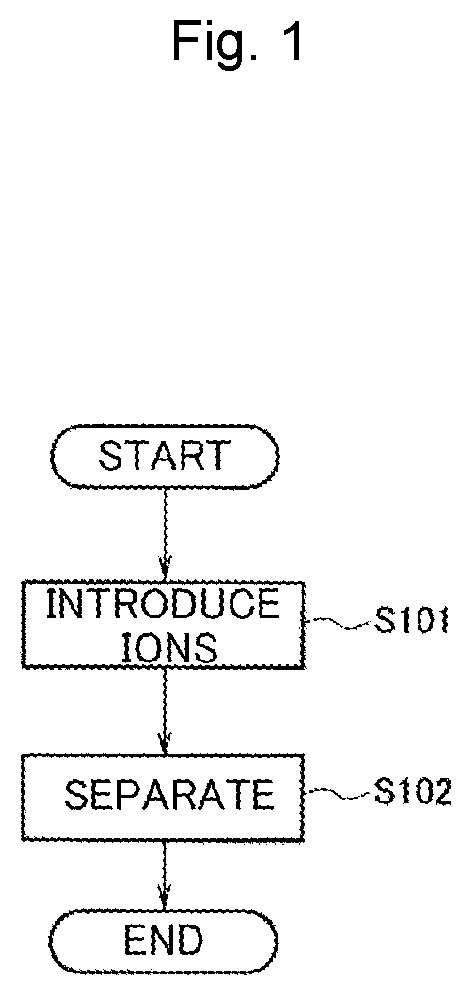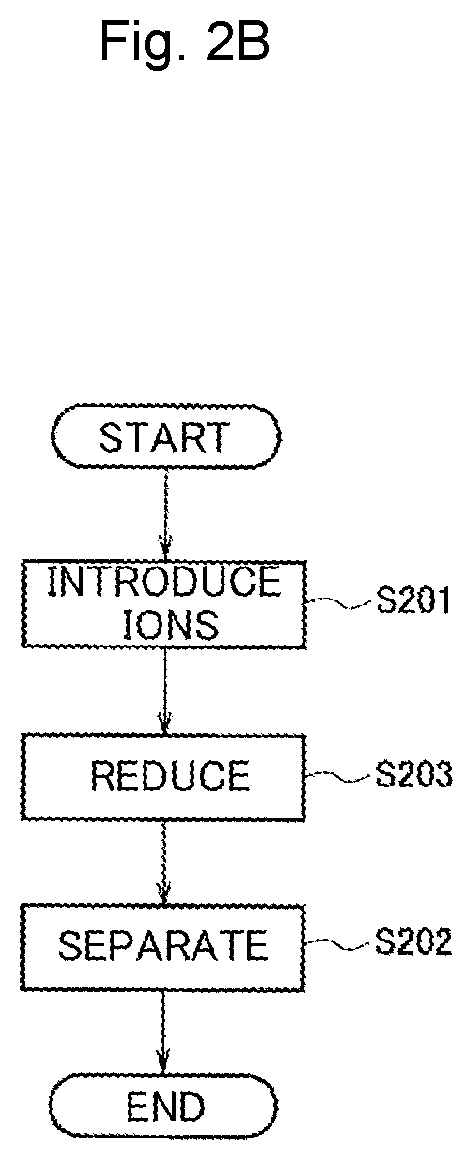Protein Template Dispersion, Method of Producing Protein Template Dispersion, and Method for Producing Alloy Nanoparticles
- Summary
- Abstract
- Description
- Claims
- Application Information
AI Technical Summary
Benefits of technology
Problems solved by technology
Method used
Image
Examples
example 1
[0053]As Example 1, an example in which a commercially available apoferritin solution (commercially available from Tokyo Chemical Industry Co., Ltd.) was used as template proteins, iron ions and copper ions were used as metal ions, and a dispersion solution of heterogeneous metal-ion-containing protein templates was prepared according to the production method in FIG. 1 is shown. Desired alloy nanoparticles could be prepared by replacing apoferritin with another material and replacing iron ions and copper ions with other metal ions.
[0054]The apoferritin solution had a form of ferritin having no ferrihydrite stored in the inner shell of ferritin. In this example, an apoferritin solution obtained by diluting a commercially available apoferritin solution with a HEPES buffer solution to 10 wt % was used. The commercially available apoferritin solution was collected from a horse's spleen and contained proteins composed of the elements C, H, O, N, S, and the like. Commercially available ap...
example 2
[0058]As Example 2, an example in which a protein template dispersion solution containing iron ions and copper ions was reduced by the production method in FIG. 2A to prepare a dispersion solution of alloy-nanoparticle-containing protein templates is shown.
[0059]The ion introduction step of Step S201 and the separation step of Step S202 were the same as those of Example 1. In Example 2, the dispersion solution prepared in Example 1 was used.
[0060]In the reduction step of Step S203, 150 μL of 0.2 mol / L sodium borohydride was added as a reducing agent to the dispersion solution prepared in Example 1. Then, it was visually confirmed that the color of the solution changed and the reduction reaction occurred. This is because heterogeneous metal ions were made into alloy nanoparticles due to the reduction of metal ions.
[0061]When the protein template dispersion solution containing iron ions and copper ions was reduced, a protein template dispersion solution containing alloy nanoparticles ...
example 3
[0063]As Example 3, an example in which alloy nanoparticles were produced while reducing the dispersion solution of heterogeneous metal-ion-containing protein templates prepared in Example 1 and an example in which alloy nanoparticles were produced from the dispersion solution of alloy-nanoparticle-containing protein templates prepared in Example 2 are shown.
[0064]First, an example in which alloy nanoparticles were produced while reducing the dispersion solution of heterogeneous metal-ion-containing protein templates according to the production method in FIG. 3C will be described. Here, the dispersion solution prepared in Example 1 was used.
[0065]The ion introduction step of Step S301 was the same as that of Example 1. While the dispersion solution prepared in Example 1 was subjected to the separation step, the separation step may not be performed in the production method in FIG. 3C.
[0066]In the reduction step of Step S303 and the template removal step of Step S305, first, commercia...
PUM
| Property | Measurement | Unit |
|---|---|---|
| Fraction | aaaaa | aaaaa |
| Fraction | aaaaa | aaaaa |
| Particle size | aaaaa | aaaaa |
Abstract
Description
Claims
Application Information
 Login to View More
Login to View More - R&D
- Intellectual Property
- Life Sciences
- Materials
- Tech Scout
- Unparalleled Data Quality
- Higher Quality Content
- 60% Fewer Hallucinations
Browse by: Latest US Patents, China's latest patents, Technical Efficacy Thesaurus, Application Domain, Technology Topic, Popular Technical Reports.
© 2025 PatSnap. All rights reserved.Legal|Privacy policy|Modern Slavery Act Transparency Statement|Sitemap|About US| Contact US: help@patsnap.com



